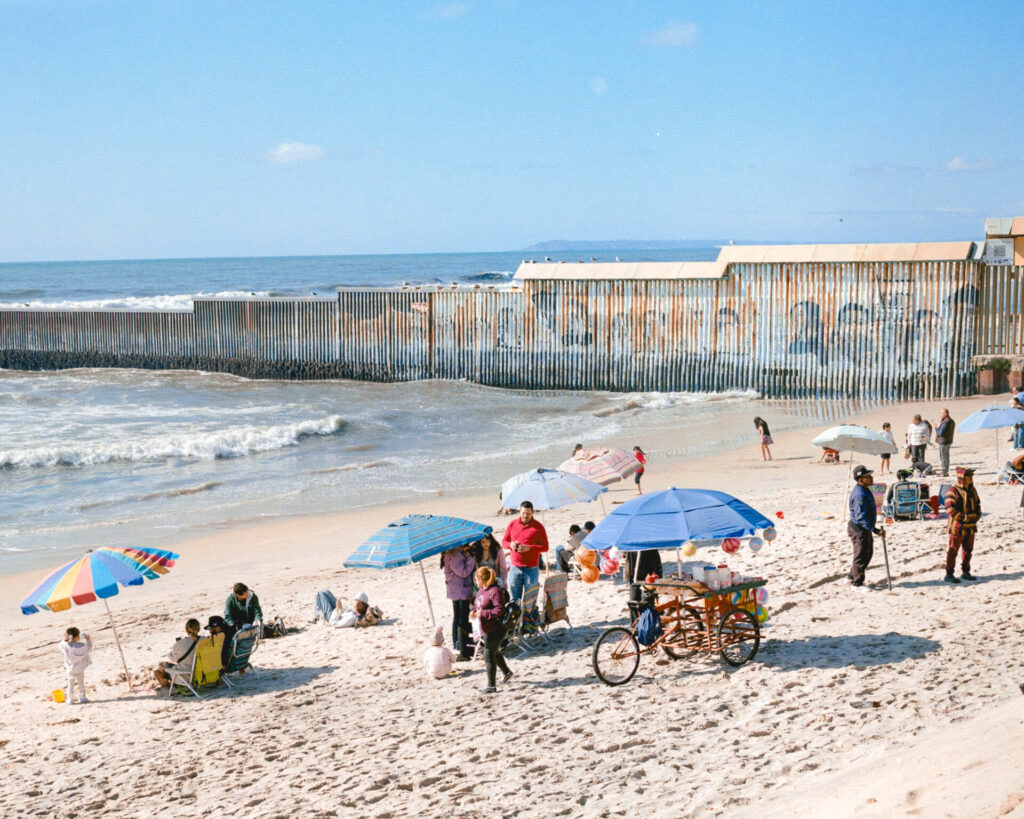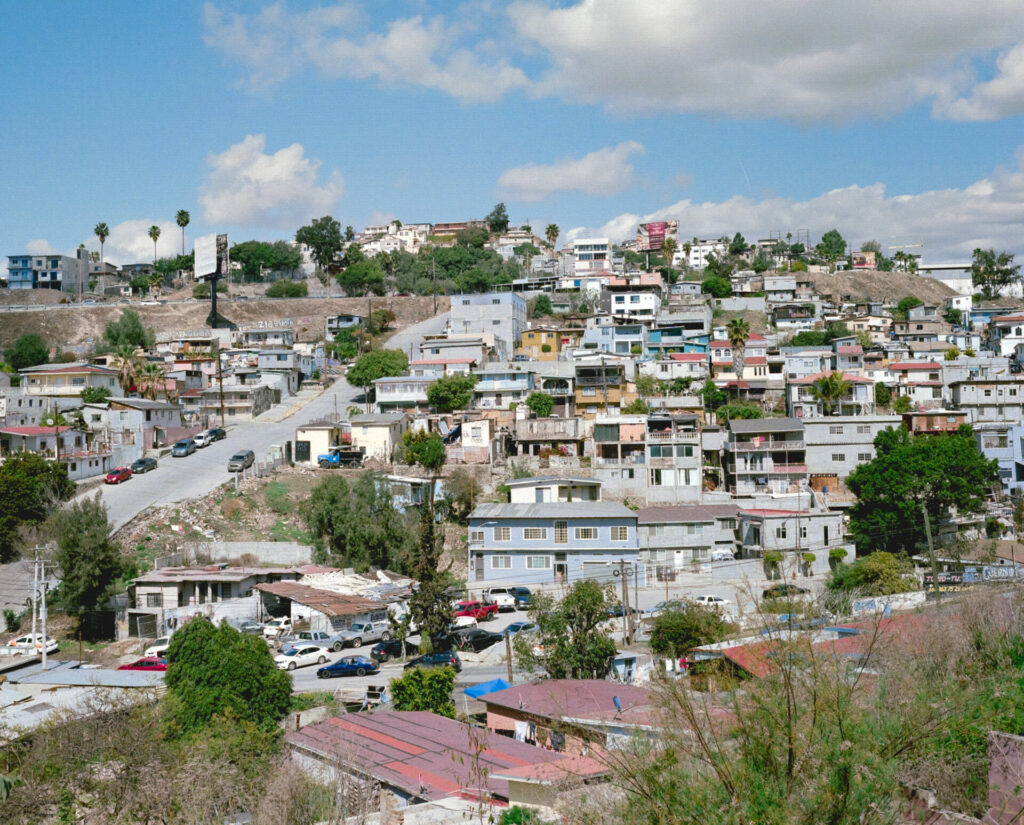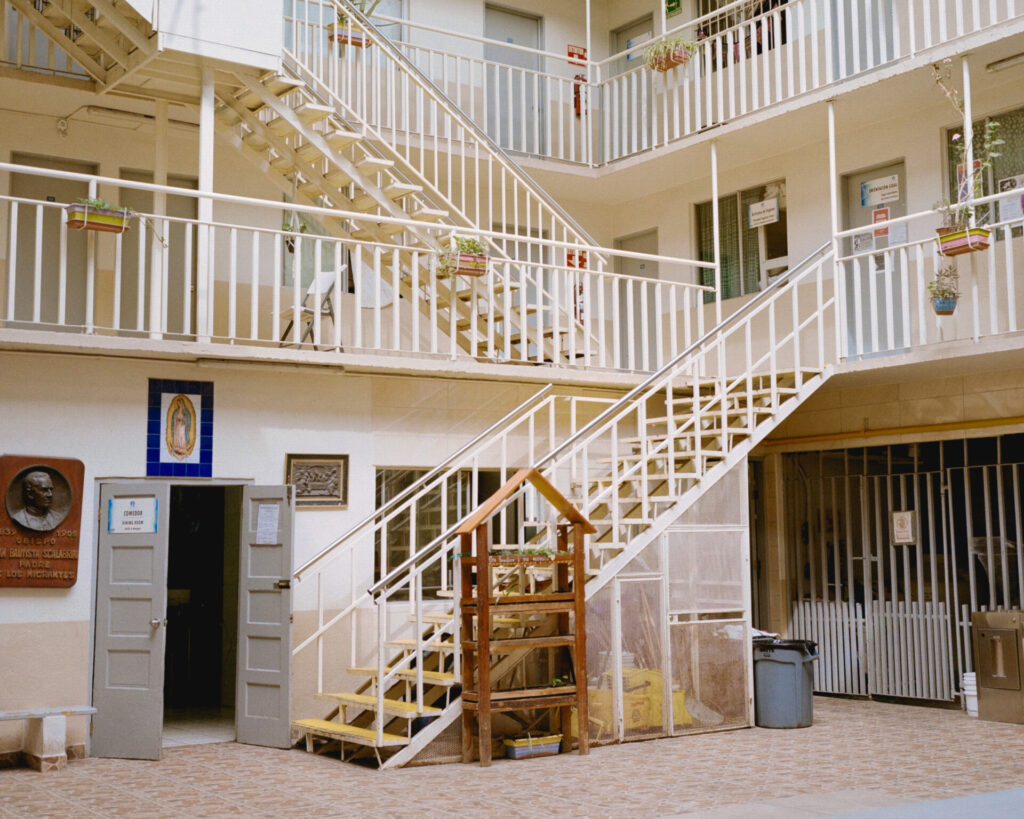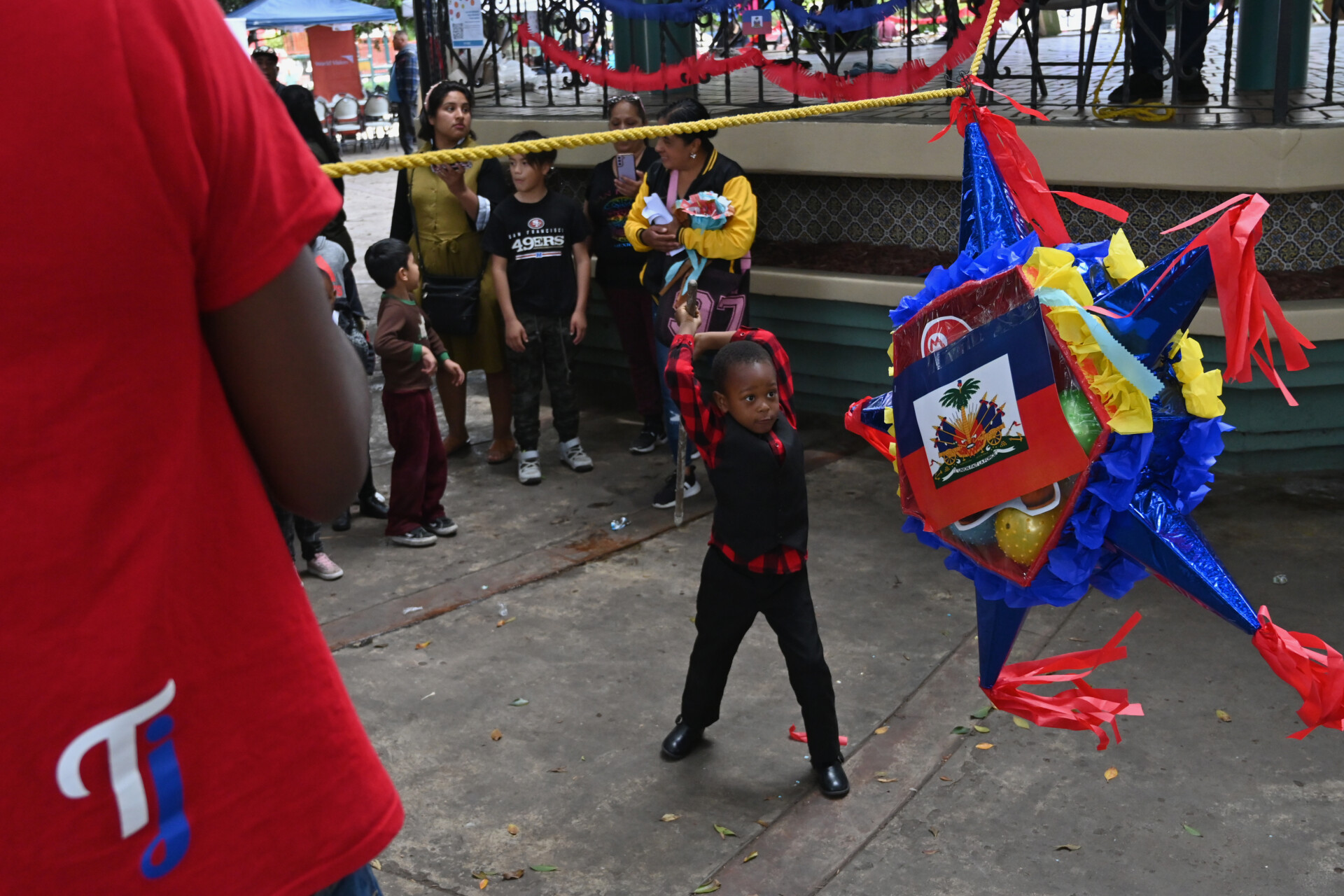When Sani Mohammed finally pulled up to Tijuana, it was dark and he was exhausted. His journey had taken a total of 13 months and spanned seven countries and three continents. At last, there was some respite: He knew he could look forward to a hot meal and a bed to sleep in.
It was the second time that Mohammed had come to the Mexican border city from his native Ghana, but this time was different — Tijuana was no longer a stopover, a springboard to make the final and most perilous leg of his journey. Instead, it was the destination.
With his bags, Mohammed ventured into the gray, squat building that is Albergue Assabil, Mexico’s only shelter for Muslim refugees, content in the knowledge that there would be halal food. To his surprise, he already knew a handful of the men there, having met them just a few months before, detained in the United States. After catching up, they invited Mohammed to visit the beach later that week. He readily accepted, and the men spent the day in and out of the water, playing in the waves and digging holes in the sand. Mohammed felt a glimpse of the peace he’d been searching for. “We were living,” he told New Lines.
Ask any foreigner why they first came to Tijuana, and they will likely recount their vision of the American dream, of a plan to traverse the world’s busiest border crossing and journey into the U.S., a place where there is justice, support and security for all, and the chance not only to earn a living for oneself but also to support family back home.
But lately, that appeal has dimmed. In April, Mexican television ran U.S. government adverts warning those who wished to cross the border. “We will hunt you down,” chimed the voice of Homeland Security Secretary Kristi Noem. The threats are not empty. Border agents have expanded powers to indefinitely detain, immediately deport and separate families who make the journey illegally. Immigration and Customs Enforcement, or ICE, has been mandated by President Donald Trump to make up to 3,000 arrests per day. The message got through. “The U.S. is closed,” was the echoing cry across Tijuana’s dozens of refugee shelters when I visited in February. Many were hosting only a fraction of the numbers seen in recent years.
Yet, despite the halted dreams and stalled plans of migrants, the U.S. closure doesn’t necessarily mean the end of the road. If anything, it has cemented the city’s transformation from a gateway to America to a cosmopolitan metropolis, a process that was already well underway when Trump was inaugurated this year.
“I started to understand that the American dream is kind of a lie,” said Vivianne Petit Frere, who runs a restaurant in Tijuana serving dishes from her native Haiti. “I didn’t want to chase illusions anymore. … I didn’t want to suffer anymore. So, I stayed in Mexico.”
Petit Frere is far from alone. Just over half of the city’s population was born outside of Baja California, the state in which Tijuana is situated. Curiously, this number has held steady over the last quarter of a century, as six U.S. presidents came and went, tightening and loosening the screws on migration policy with each administration. And while most newcomers are internal Mexican migrants, according to the 2020 national census, sizable numbers of people arrived from Venezuela and Haiti in the last five years, as well as hundreds who journeyed from Guatemala, Colombia and Brazil. Over 26,000 deportees from the U.S., most of them Mexican, made Tijuana home during that time.
Tijuana’s unwavering migrant population in the face of shifting U.S. policy means that there must be something that holds people here, something beyond what America decides, something more than a dream that didn’t work out, something that, perhaps, can only be found on this side of the border.
At first glance, the concrete metropolis that is Tijuana pales in comparison with the honey-soaked dream sitting on the other side. The city’s architecture is shaped by movement — restricting that of some, allowing that of others. It is a place defined by the populations that have arrived and settled, a place of everywhere and nowhere, alluring for someone who arrives as an outsider, looking for a way to begin all over again.
The Mexican military patrols the streets, deployed in an ongoing operation by President Claudia Sheinbaum to hunt down drug smugglers in exchange for the halting of U.S. tariffs. Footbridges turn into bottlenecks flanked by guards for those who have the right to get in and out of the U.S. Then there is the border wall itself, rusting on the horizon with desolate hills sitting beyond its barbed wire.
While the U.S. largely views Mexico as both a transit route for international migrants and a source of refugees, the country is increasingly becoming a destination in its own right, accelerated by the U.S. decision to seal the border. In Tijuana, something different is brought with each new community — a new flavor, sound, dance, or religion — contributing to the fusion that makes the city. When its first restaurant offering Ghanaian halal dishes opened just under a year ago, Mexican TikTokers dived into a plate of banku dumplings and okra stew with delight, boasting about how multicultural their city had become.
According to Centro 32, an organization that supports migrant integration into Tijuana, there is a local openness toward migrants, a willingness to give newcomers a chance that stems from shared recognition. “Tijuana is made by migrants. That’s how Tijuana was born. Our roots are migration,” said Lourdes Medrano, the founder of Centro 32, named after the city’s latitudinal position.

“You don’t know America, but still you say, ‘I will go to America,’” Mohammed said, his voice rhythmic and smooth. His large eyes light up when he recalls how he first pictured the U.S.: a place where people were given a second chance. As a child, Mexico occasionally came up in conversation among friends, but only as a place associated with gangs, criminals and financial insecurity, an unavoidable stopover on the way to the land of opportunity. “Everybody’s heard about Mexico,” he said. “But you’ll never hear anything good about Mexico.”
When his personal situation left him feeling unsafe, Mohammed first fled Ghana in April 2023, when he was 35, in the earnest belief that now that he was in need of help, America would provide it. His first stop was Turkey, followed by Brazil, Peru, Panama, Nicaragua, Mexico and, finally, the U.S.
In the last few miles through Mexicali, another of Mexico’s border towns located two hours from Tijuana, he met a man who told him to follow a road that would take him across the wall without having to climb. Mohammed followed his instructions, thinking it was a legitimate route.
But his dream collapsed as his feet crossed over the final border. He was quickly detained by agents and spent the next four months being shuffled across U.S. detention centers before being sent back to Ghana. The worst part was that he didn’t know what he had done wrong. Being detained and not knowing when it would end left him traumatized and feeling like a criminal for seeking asylum, an act he thought was within his rights. “I’m not a criminal. I didn’t sell drugs. I didn’t beat anyone, kill anyone,” he told me.
Eight months later, as Mohammed stood outside Albergue Assabil for the second time, it felt different. He’d been able to get the documents he needed to fly directly from Ghana and had entered the country without pushback. He now had 30 days to make his asylum claim to remain in Mexico — with some peace of mind, knowing that about 70% of refugee applications made from within the country are granted.
Despite the proximity, he detested the thought of returning to the U.S. And after his first few weeks in Tijuana, he started to feel something pivotal, something he hadn’t come close to in the U.S. He felt relief.

Just hours into Trump’s first day in office, the right to claim asylum at the southern border ended when CBP One, the cellphone app used to request it, was shut down. Simultaneously, the presidential Proclamation 10888 declared that people arriving at the border constituted an “invasion” against which the U.S. needed “protection,” meaning that asylum could be indefinitely blocked, until the U.S. said otherwise. That has left people with two options: try their luck with the forces ranged against them, or come up with a new plan.
In 2023, 140,000 people applied for asylum in Mexico, according to the United Nations refugee agency. The majority of them came from Latin America, but there were also significant numbers from Angola, Afghanistan, China and India. The Taliban takeover of Kabul four years ago, in particular, prompted a wave of ongoing Afghan movement to Mexico, estimated by migrants to number in the thousands.
Since Trump took office in January, those numbers have only swelled. While Mexico’s refugee agency is yet to release the data, it was widely reported that the figure in January was more than triple the monthly average from the previous year. This would mean, according to an unnamed international official cited by global news outlets, that Mexico has seen more asylum applications than at any time in recent history. Up to 1,000 migrants are making first requests each day.
The surge in demand has placed considerable strain on Mexico’s asylum system, creating longer wait times for appointments and processing, worsened by cuts in the U.S. aid on which Mexico’s refugee agency, COMAR, relied in order to function.
The result has been overwhelming. Earlier this year, local aid agencies reported that people camped outside COMAR offices in Mexico City to get their first appointment — a sight that is becoming more common.
“We are very worried about this because it is happening in the same context that migration is [increasing] in the south, the north, and in the center of the country,” said Lucía Chavez from Asylum Access Mexico, a nongovernmental organization, adding that this has compounded fears of services being stretched thin.
As entry points, Mexico City and Mexico’s southern border host some of the country’s largest refugee hubs. But once people have the papers they need to move legally throughout the country, many head north to border towns like Tijuana, undeterred by the violence. The city consistently ranks as one of the most deadly, not only within Mexico but globally, primarily due to cartel-related gang violence. Officials in Baja California said 1,807 people were killed here last year, averaging around 150 each month. Local Facebook groups are filled with pictures of missing people who were last seen here, shared by desperate relatives.
Yet Tijuana still holds appeal, and migrants are motivated by both job prospects and being closer to a dream they once had, even if it is not realized and they do not manage to cross over. The city hosts major manufacturing hubs for companies like Samsung, Toyota and Boeing, fueled by U.S. demand and powered by cheap labor — people who may lack skills or language proficiency but need to begin working immediately and are willing to accept long hours and grueling conditions, at least at the start. Then there are the call centers, hotels, restaurants and construction sites, many of which depend on people willing to work flexibly and to start right away.
When Petit Frere arrived in Tijuana from Haiti at the end of 2019, she didn’t have much of a plan. The only Spanish she knew was a salutary “Buenos dias.” Her only hope was to find work quickly and then wait for a legal pathway to cross the border. She had sold her family home to make it this far and her mother and two young children were counting on her to succeed, so they could claim family reunification once on the other side. This meant that deportation back to Haiti was not an option she could afford.
Petit Frere quickly found work as a night-shift cleaner at a hospital, made especially grueling by the fact that it was used for cosmetic surgeries, like liposuction and the procedure known as the “Brazilian butt lift.” “It was very hard, very tense,” she said. “I cleaned every night, floor by floor.”
Mohammed’s trajectory was similar. Within weeks of arriving, he found a job in construction, working six days a week from 6 a.m. to 9 p.m., earning just enough to rent a room. Despite the punishing hours, he is still working there today. Mohammed says it’s worth it for how he is treated by his Mexican boss, who took a chance on him even though he didn’t speak Spanish, and continually shows him respect.
“I’ve been with a lot of people, but I’ve never met such a kind man before,” Mohammed said. “When you don’t eat, he says, ‘No, you have to eat first before you work.’”
It isn’t only the work opportunities that have historically kept people here, even when the U.S. was more accessible, said Medrano of Centro 32. The decision to stay typically comes later, after people have had time to discover what life on this side of the border can look like.
After direct flights between Tijuana and Shanghai began in 2008, with Beijing added a few years later, the Chinese population in the city soared, and is believed by locals to be much higher than the official number of 10,000. Some years later, on a desolate hill in the west of the city, Little Haiti was born, as Haitians arrived in their thousands, fleeing political instability and natural disasters in their country. In more recent years, the war in Ukraine has seen the most significant Eurasian migration since the Soviet Union fell almost 35 years ago.
That melting pot creates opportunity — it’s easy for people to slip into local networks without needing Spanish. Social media is flooded with people sharing information in their native languages: which supermarket stocks the cheapest food, who has spare kitchen utensils. It travels all the way back home, detailing how to arrive and what life here can offer. These networks give people a chance to belong, offering community to those whose very identity feels separate from the place in which they find themselves.

The Rev. Pat Murphy is a slow-moving, 73-year-old priest, himself a descendant of Irish migrants. He abandoned his native New York to become director of Casa del Migrante, one of Tijuana’s Catholic refugee shelters. Affectionately called “Padre Pat” by his flock, he first visited Tijuana in 1993 when the shelter needed emergency support after a priest got sick, and loved it so much that he took up the post of permanent director when the opportunity arose 20 years later.
Tijuana’s constant coming and going of people reminds Murphy of the buzz of New York. There is also a sense of optimism among the migrant community that he says comes from knowing the value of being here today, doing better than yesterday, and hoping tomorrow may bring something new.
“The second American dream is this. There are job opportunities, places to rent. You can send your kids to school without a problem. It doesn’t matter which country you’re from. It can be a good life,” he says.
The city itself is built on the shoulders of migrants, says Murphy, as many take construction jobs to keep up with its constant expansion, like Mohammed. Since arriving over the last decade, Haitians have evolved from street vendors to business owners and government workers, making solid contributions to the city’s cultural landscape — like the music group “Haiti Juana” which blends Haitian pop with local sounds.
Tijuana and nearby Mexicali are famous for their Mexican-Chinese fusion cuisine that has created regional staples like shrimp rolls with cream cheese and cilantro. The Chinese Community Association organizes annual events, often attended by city officials. Chinese New Year, in particular, makes an impressive mark, turning the city center into a festival offering music, dance, exhibitions and fireworks.
U.S. deportees also make contributions to the city. Daniel Ruiz founded the EZ Call Center, staffed almost exclusively by people expelled by the U.S., to provide employment for those who speak perfect American English. They call up people across the border, offering services like debt collection on behalf of American businesses. Ruiz, who was deported by the U.S. for a minor drug crime, also wanted to create a community among people now stuck in a country that many barely remember, who have often been separated from family members on the other side.
Since it opened its doors three years ago, Albergue Assabil has been welcoming migrants from Arabic-speaking countries and Africa. But with such multiculturalism can also come prejudice. Some who make the journey say locals show hostility and racism, specifically to those who come from abroad, and are more likely to favor fellow Mexicans.
“Tijuana is a bit strange because it’s a mix of everything,” said Elisabeth, 27, who arrived in Mexico from El Salvador in September 2023, coming to Tijuana in October last year, hoping to make it to the U.S.
“We’re few and far between, and people look at us strangely. They always say, ‘El Salvador — gangs.’ They think we’re here for bad reasons. Sometimes people judge us without knowing that we didn’t come here because we wanted to,” she said, declining to give her last name. But regardless of discrimination, she still feels relief to be in a place where she can earn, where she is no longer being persecuted, and that isn’t the U.S. right now.
“We feel like we’re better off here because we’re not being persecuted, like being hunted. … If we manage to cross, we’re going to be like the others who are there right now — suffering, being persecuted, hiding. They’re afraid. We say it’s better to stay here. Here, we are legal,” she told me.
Soon after Petit Frere arrived, she began attending workshops called “Know Your Rights,” organized by the Haitian Bridge Alliance, which advocates for migrant rights, and lawyers from the University of San Francisco. Something clicked. She realized what life in the U.S. would likely look like for someone from her background, and felt that, while there may not be the same level of poverty as in Haiti, the system operates on what she sees as extortion, through exploitative employment and the high costs of maintaining legal status. Asylum-seekers are expected to pay at least $500 for work permits that must be renewed every year or two. Green-card applicants face much steeper costs, at $1,760.
After four years in Tijuana, Petit Frere now runs her own restaurant, Lakou Lakay, or “home yard” in Haitian Creole, named because it’s a place where people come to celebrate community. Initially, only Haitians came to dine, but lately there’s been an uptick in Mexican and American guests. She describes her restaurant as a space for people to gather, listen to music, dance and enjoy life. “It’s joyful,” she said.
She believes she has achieved what she set out to find in America: a good job, education and reunion with her family. “But I was able to do all that in Tijuana. So, in a way, I found my American dream here in Tijuana.”
It’s now been a year since Mohammed arrived in Tijuana. He hasn’t been back to the beach — his work hours make that tough — but he still goes to Albergue Assabil to eat in the evenings, usually sitting with the small trickle of people continuing to arrive from Ghana. He has almost completed the final steps of getting permanent residency in Mexico, too.
The stories he heard as a child of gangs, criminals and financial insecurity in Mexico may be true, but what Mohammed didn’t expect is how it would be possible to live a life here without fear of persecution, both from the state and also locally, and without feeling like a criminal.
“Being here, it’s not like I say, ‘Oh, I want to be rich,'” he told me. “I want peace. I want peace.”
Sometimes, friends who made it to the U.S. call to ask when he will try to cross again. “You are in America,” he tells them. “Let me be in Mexico.”
Sign up to our mailing list to receive our stories in your inbox.



